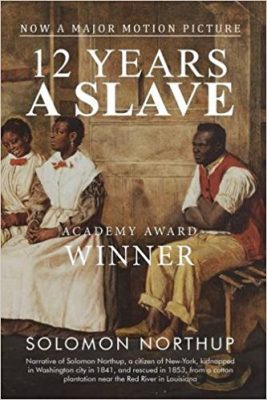
Solomon Northup, born 1808, died around 1863, was a slave for 12 years from 1841 to 1853. What about the rest of his life? What about his life as a free person for the first 32/3 years of his life? What about his life for the last ten or so years of life?
In the movie version of his story, there are brief snippets at the beginning and end of his life in freedom. He is shown with his family in his home in his community but only fleetingly. Still there is enough there to pique one’s interest. All of his life in New York was as a free person. He established a family and earned a living as a free person. That story isn’t told wasn’t told in the movie.
Northup’s life marks the beginning of a new era in New York State history for middle passage blacks. By 1827, some were already free; after 1827 almost all of them were. Now they were living as free people not just in the city of New York but throughout the state. What’s their story?
AFRICAN AMERICAN CEMETERY
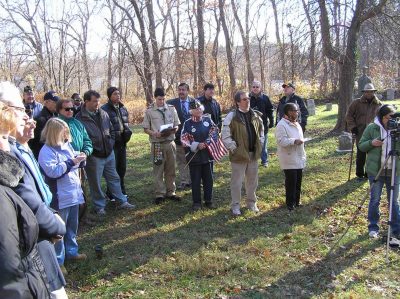
In the Town of Rye where I live, the town owns what is now called the African American Cemetery. It is located in the City of Rye which formerly had been part of the town. It is located adjacent to the formerly white-only Greenwood Cemetery in Harrison near Halstead Road on land donated by Underhill and Elizabeth Halstead in 1860. The land contains 379 burials including for veterans from the Civil War, the Spanish American War, and World War II according to the list distributed at the Veterans Day ceremony on November 4, 2017. The town website also mentions World War I. The cemetery closed in 1964 was effectively abandoned afterwards. It became home to immensely high and thick weeds. Eventually, Dave Thomas, a Town of Rye employee, led the effort to restore it. In the last decade there have been annual ceremonies there, a kiosk has been installed, and Eagle Scouts have earned merit badges for their work there. It is a part of local history that still is known only by a few including descendants of people buried there.
THE HILLS
Speaking of Harrison, next door, in that community there was a place called The Hills. According to the town website:
The Hills refers to the area of Harrison, North Castle and White Plains where the largest concentration of African-Americans in Westchester County lived through 1870. Many of the early settlers were former enslaved people who had been voluntarily emancipated by religious orders such as the Quakers and the Methodist-Episcopalians beginning in the early 1770’s. The Hills was a cohesive community with strong family relationships, its own church, school and cemetery. Thirty-six Hills residents fought in the Civil War, contributing to the effort to end slavery and preserve the Union.
This collection is a representation of the history of the Hills community beginning in 1790 through 1925. The documents include census data, area maps, original school records, a church mortgage, land deeds, letters of a civil war soldier, veterans pension claims, and newspaper articles about Hills residents. They reflect the development, stability, and economic viability of the community.
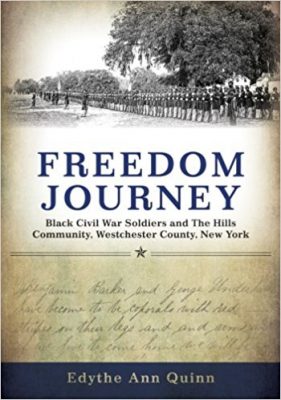
In this instance, the person spearheading the effort to document and tell the story of Hills was the local town historian, Edythe A. Quinn, now a history professor at Hartwick College in Oneonta. She is the author of “The Hills” in the Mid-Nineteenth Century: The History of a Rural Afro-American Community in Westchester County, New York (1988) and Freedom Journey: Black Civil War Soldiers and The Hills Community, Westchester County, New York (2015). At my invitation, Edythe spoke to the Westchester social studies teachers at an annual conference. Still my impression is that this piece of local lore is not fully integrated into the school curriculum.
SENECA VILLAGE
A better known community of free blacks in the 19th century is Seneca Village. It had the misfortune to be located in what would become Central Park and the good fortune to be located almost directly across the street from the current location of the New-York Historical Society. Information about this integrated community can be found at the website of the Conservancy of Central Park. An archaeological dig of the site in 2011 uncovered stone foundation walls as well as individual artifacts, including what appeared to be an iron tea kettle, a roasting pan, a stoneware beer bottle, fragments of Chinese export porcelain, and a small shoe. Leading the effort have been Diana DiZegra Wall then of the CUNY Department of Anthropology, Nan A. Rothschild, Department of Anthropology, Barnard College, and Cynthia Copeland then of the New-York Historical Society. In reading an article they wrote, I noticed in the bibliography some readings which further shed light on this period in history that may be of interest:
Rhoda Golden Freeman, The Free Negro in New York City in the Era before the Civil War (1994)
Leslie M. Harris, In the Shadow of Slavery: African Americans in New York City, 1626-183 (2003).
Recently on New York History Blog there was a notice for a new book, Black Gotham: A Family History of African Americans in Nineteenth-Century New York City by Carla Peterson. It is described as part detective tale, part social and cultural narrative of the author’s quest to reconstruct the lives of her nineteenth-century ancestors. As she shares their stories and those of their friends, neighbors, and business associates, she illuminates the greater history of African-American elites in New York City.
WEEKSVILLE
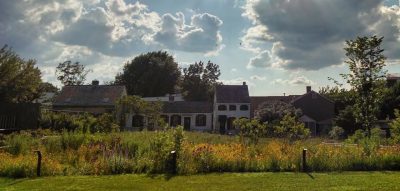
One final location in the city to be mentioned before returning north to Northup is Weeksville in Brooklyn. According to the Weeksville Heritage Center
Weeksville, part of the present-day neighborhoods of Crown Heights and Bedford-Stuyvesant, was an independent free black community, named for James Weeks. Weeks purchased property in 1838, along with other African American investors, in order to create an intentional landowning community. Continuing the legacy of self-determination, Weeksville’s history was rediscovered in 1968 when urbanization threatened to erase the physical memory by destroying the few remaining historic homes. Instead, a grassroots preservation effort was led by James Hurley, Dewey Harley, Dolores McCullough, and Patricia Johnson, and eventually artist and activist, Joan Maynard to preserve the Hunterfly Road Houses and the memory of historic Weeksville.
Everyplace has a Weeksville, where ordinary people came first and labored to create a more hospitable living setting for their loved ones. The rediscovery and preservation of this local history provides a means of reestablishing a continuity with the past so that children, armed with the knowledge of the contributions of their forebears can gain strength to meet the challenge of the future.
Needless to say the last line is a critical one on why local history is important. Unfortunately the use of “forebears” could be interpreted to mean Weeksville is only for black people. As was shown in the Hunts Point Slave Burial Ground in the previous post, Undoing the Whitewashing of Black History in New York, the nearby elementary school includes students of multiple races and it is unlikely that the slave burials were of any of their forebears. Furthermore with the Great Migration, it is more likely that the forebears of black people in the Brooklyn community now were in the south then rather than in 19th-century Brooklyn. The theme should focus on the “ordinary people” of the earlier line, their dreams, their hopes, their achievements all of which should resonate with people of all backgrounds today.
Weeksville has a tough road to hoe given its location in a commercialized section of Brooklyn. Truth be told, when the Weeksville Heritage Center staff attend history museum conferences, generally in upstate New York, they tend to stand out from other attendees. This reality was made clear by a former director of the site at a memorable closing session of a MANY conference. This condition is part of a larger issue on the place of history and its stewards at the local, state, and national level.
THE MYERS HOUSE
Turning north, the Capital Region also has a site with a story to tell about free blacks in the 19th century. When Paul and Mary Liz Stewart began investigating the Myers House, it was in connection with the Underground Railroad. Over the years they have carved out a place for themselves on this topic in New York through the creation of the Underground Railroad History Project. It holds an annual conference with the next one March 9-11 in conjunction with the annual New York State Social Studies Conference also In Albany this year.
Somewhere along the line they realized that there was more to the Myers residence than the Underground Railroad. Just as Solomon Northup had a life as a free black before and after his captivity, so the Myers had a life that extended beyond the Underground Railroad. Like Northup, they were free blacks with a family and a home who earned a living as free people. The research then shifted from solely focusing on the Underground Railroad to investigating the jobs, professions, and lives of the free blacks who were a community in Albany. So besides restoring the home (and the first time I was there with the teachers it definitely needed a lot of work!), the research has branched out to include an archaeology dig with the SUNY Albany Field School and developing a picture of the fully active 19th century free black community.
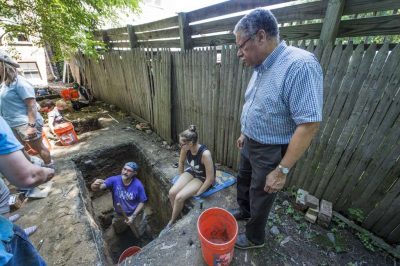
ADIRONDACKS
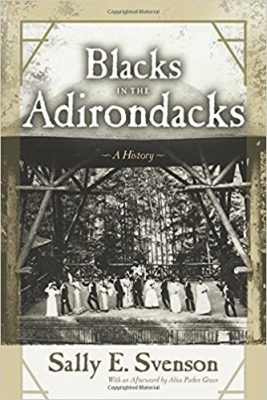
Even further upstate, an active person in telling the story of free blacks has been Sally E. Svenson. She is the author of Blacks in the Adirondacks: A History (2017). She also has an article on “Brookside: An Integrated Cemetery in the Adirondacks” in the current issue of New York Archives. The cemetery is closely connected with Gerrit Smith who donated land to free black farmers to settle in the Adirondacks. Smith figures prominently in the events at the National Abolition Hall of Fame and Museum in Peterboro. Dot Willsey sends me notices of all the events which is only fair since I send her my posts.
Finally to close the circle, let’s return to Solomon Northup. Last fall, SUNY Adirondack’s Continuing Education division offered a class on him. The class was taught by David Fiske, the co-author of the book, Solomon Northup: The Complete Story of the Author of Twelve Years a Slave, and the author of Solomon Northup’s Kindred: The Kidnapping of Free Citizens before the Civil War. Presumably there is more being taught then just the 12 years of his captivity.
So what we can learn from this admittedly partial overview of mostly 19th century life of free blacks in New York?
1. They weren’t slaves. They were free people who had families, owned homes, had farms, and had money-earning skills in a variety of jobs and professions. In other words there was more to their lives in the New York than being part of the Underground Railroad. The minimizing of their lives as slaves in the New York State history is matched by a minimizing of their lives as free people after 1827 by restricting it to the Underground Railroad.
Consider the movie Brooklyn (2015), the story of an Irish immigrant to America in the 1950s who lives the American Dream. She was not a superhero. She did not change the course of human history. She did not stand out as she was one of many who eventually found their heaven on earth after an intermarriage to an Italian and a dedication to education. Solomon Northup was doing that over a century earlier but that story is only glimpsed at the beginning and end of the movie.
2. There is more to black lives than being rescued by the white savior. Yes, it’s great that the godly Brad Pitt helped free Northup from captivity but notice that limited life being assigned to black people – they are victims. We all are aware of how important victim ideology is in the political arena today. Elitists love to tell the story of a Joe Louis or Jackie Robinson but what about the black Saoirse Ronan who stars in Brooklyn. Free blacks had a life in New York beyond the Underground Railroad with stories to tell just as Irish, German, Italian, Jewish, and immigrants from countries besides Norway have to tell. But those stories aren’t told.
3. Preserving the physical heritage of that history is a challenge. Besides the abandoned cemeteries and rundown houses I mentioned in this post, there are problems with the preservation of these cemeteries beyond New York State as well (see “Perpetual Neglect: The Preservation Crisis of African-American Cemeteries”).
If we had a New York State history conference, the story of free blacks would warrant an annual session. How many such communities were there throughout the state in the 19th century? What happened to them? What physical remains are there of these communities? Where are the artifacts stored? What is included in the k-12 curriculum? Since there are problems maintaining the local history of white people, the challenge is even greater with black people, people who have been here as long as the Dutch, the Huguenot, the Palatines, and the English.
As I continue to move through the time line exploring this history in New York, we will see that decisions have been made by middle passage blacks about how they view themselves within America as free people seeking to live the American Dream, as victims, and as a people now at a crossroads.






Peter – We have found some interesting information in the Bowne House archives related to abolition. Thought you might like to see what we are doing for Black History Month. There is an old African cemetery in Flushing, which is being considered as a landmark.
Best,
Rosemary
Hey Peter;
Thanks for the email. I find the story idea about telling Solomon Northrup’s story very interesting. Would there be a good person to interview about the ‘rest of his life’ in New York, and about the times – both before his abduction and after? As you touched upon, it would be interesting to review what was going on in New York history vis-à-vis blacks and slavery. I would also be interested to know if what happened to Northrup was prominent, very rare, or somewhere in between. Also, what was done about such activity? Please let me know about interview options and sources for the story. I know he had a home in Saratoga Springs; we’d also be interested in any other Upstate connections given our audience.
Thanks;
Chris
Chris A. Bolt | WAER News and Public Affairs Director
WAER.org
Syracuse University
WAER 795 Ostrom Ave
Syracuse, New York 13210
Great article. Thank you. Keep up the good work. We have a slave cemetery in New Paltz that has a NYS historic marker. In Highland, there is one with no marker. My mother-in-law did find it and marked it at the time, but that information is lost. Perhaps the Town of Lloyd historian has that information
I always thought it was a tough row to hoe?
road to hoe
Viv
After a quick search, it seems like the original phrase was a “hard row to hoe” which certainly makes sense. Then it also became a “tough row to hoe” and then in the 1960s mistakenly became a “tough road to hoe” and that caught on. I suspect the introduction of a consonant helped separate “row-to-hoe” into three separate words instead of one which flowed together.
For what it’s worth, or not worth???
THE SOLOMON NORTHUP/NORTHRUP CONTROVERSEY
On November 1st. 1907, the Amsterdam Evening Recorder printed a column entitled, ‘Reminiscences of a Lawyer’, by Johnstown Attorney Donald McMartin. The subject was Solomon Northup or Northrup, the Glens Falls free Afro-American who in 1841, as history relates, was tricked into going to Washington with two Broadalbin conmen, drugged, and sold into slavery. Rescued ten years later, Northup’s story, “Ten Years a Slave’ when published caused every bit as much indignation against slavery in the north as did Alcott’s ‘Uncle Tom’s Cabin.
A recent film recounting Northup’s ordeal is claimed to portray his story accurately. Or does it? Leader Herald Reporter Arthur Cleveland recently asked if there is any truth to a totally different slant on the Northup story, as related to him recently by Adirondack Historian Don Williams. Mr. Williams shared with Mr. Cleveland another story, one greatly differing with both the original 1851 book or the 2013 movie. He stated former Fulton County Historian Dr. Palmer informed him years ago that Solomon Northup was actually in on his being sold into slavery, that he was supposed to escape and receive a third of the profits from his ‘sale’.
I had heard this alternate account before and already knew where Dr. Palmer got it – from Donald McMartin’s 1907 Recorder article. According to McMartin’s account, after Northup was rescued, “He was brought to Gloversville and prevailed upon to make complaint against Alex Merrill. The latter was arrested and lodged in the Johnstown jail. Merrill reminded Northup that the scheme to sell him into slavery was his own getting up: that he (Merrill) had given Northup $700.00, his full share of the purchase price of $1400.00. He was to take his chances of escape and did (but not until ten years later and with much help) and he, Merrill, should not be held responsible for the delay in the matter! The Negro admitted this to be true and said it was none of his prosecution. Merrill died only a few years ago at a good old age.” So claimed McMartin. But where did he get this story?
Dr. Palmer had obviously read McMartin’s 1907 article, accepted it as fact, and passed it on to Historian Williams. But was it true? If it was true, then Northup’s story, ‘Ten Years a Slave’ which brought thousands into the cause of emancipation, was a fabrication, or at best, a convenient manipulation of the truth, which seems highly unlikely.
Bur is there, Reporter Cleveland asked, any truth to Mr. William’s version? Historical facts are always hidden in musty old primary sources such as aged newspapers and, even better, personal letters and court documents, if they can be found. One might begin by consulting 1850’s era newspapers. The Oneida Sachem of July 15th, 1854, informed readers, “The rascal Merrill has been arrested near Gloversville. His assistant Joseph Russell was also arrested. They were discovered and recognized by Northup himself. The scoundrels are being examined by Judge Abel Meeker, District Attorney William T. Odell conducting the prosecution.”
The Syracuse Wesleyan of July 20th gave a fuller account. “The arrest was made at Woods Hollow, Fulton County. Solomon was at that place on Friday July 7th with his friend H.B. Northrup through whose agency he was rescued from slavery. Merrill was arrested at his mother’s and brought to Gloversville. Solomon identifies him without a doubt. Merrill has long been recognized as a desperate fellow. They found him asleep with a Bowie knife and brace of pistols on the floor by his bed. Soon after, an officer from Saratoga County arrested a canal boat captain named J.I. Russell. He was handcuffed and taken to Ballston. He admitted he was in Washington at the Inauguration in 1841.”
The most complete account was published in the New York Daily Tribune on July 15th, by which time both men were housed at the Saratoga County Jail in Ballston Spa where the examination took place. Merrill was represented by Attorney William Wait and Russell by John Brotherson. Solomon Northup’s friend, namesake, mentor, former employer and rescuer, Attorney Henry B. Northrup, also served on the prosecution team.
This lengthy article can only be paraphrased here. Northup testified that the two men hired him at Saratoga to drive their carriage to New York and play the fiddle in a circus they belonged to, that they offered him one dollar per day and expenses, that when they got to New York they persuaded him to go further south to Washington to catch up with the circus, that he first (wisely) obtained papers at the N.Y. Customs House attesting to his status as a fee man, that they went to Washington by train and arrived the night before President Harrison’s funeral, that they drank together and he became sick and insensible and “woke up in William’s slave pen with fetters fastened to the floor.” He stated he was freed January 3rd, 1853 and that “The first time he saw Merrill again was in bed at his father’s house last week.” The article concludes by stating, “The prisoners were taken in a civil suit and held to bail of $5,000.00 each to answer Solomon Northup for his personal damages in being sold into slavery”.
What happened to Joseph Russell I haven’t investigated, but Alexander Merrill was confined in the Ballston Spa jail and apparently remained for some months, during which time there supposedly occurred the Northup-Merrill meeting, the genesis for Attorney Martin’s version of the affair, as accepted by Dr. Palmer and passed on to Mr. Williams.
Merrill died December 5th, 1912 near Broadalbin. On January 15th, 1903, the Warrensburg News, recounting his major role in the 1841 kidnapping of Solomon Northup in part asserted, “While in confinement, he wrote Solomon a letter inviting him to call. The invitation was accepted, and by a pre-arranged plan, two witnesses were secreted near the cell by Merrill’s friends, who overheard Solomon admit that he had consented to be sold. Merrill soon after obtained his freedom. His later years were spent at Woods Hollow near Broadalbin. He died at the age of 89.”
If this Northup-Merrill meeting really occurred, and during it Northup really did admit he was in collusion with his supposed kidnappers, this could account for Merrill’s subsequent release. Johnstown Lawyer McMartin either read the 1903 Warrensburg article or heard the old tale through informal legal channels. But because the Warrensburg article quoted no authoritative documentation, it can’t be considered fact.
Where in Woods Hollow was Merrill’s home located? A March 28, 1892 unrelated Daily Leader article notes, “Charles Brook empties into the Kenneyetto near the residence of Alexander Merrill.” The location of Merrill’s residence could probably be discovered by researching deeds in our County Records Room.
Thus the Warrensburg News article, the likely origin of the theory of Northup’s collusion in his kidnapping, is identified, but which story is true, that represented in “Ten Years a Slave” or the Warrensburg News? If Northrup was ‘in on it’ no wonder this account was suppressed: his book, already read by millions, was an important asset to the cause of Emancipation. Even an accusation of his involvement would have ruined its credibility.
I don’t really know what the truth is. Do you?
That’s quite a story. In this era of Fake News, it is hard to know what is true. You are certainly right to advise a caution when stories to good to be true are revealed. I will print your reply and try to digest it.
Peter
Hello, Peter.
Thanks for this thoughtful post. I wish you’d known about our “Dreaming of Timbuctoo” Exhibition and could have made mention of it in the Adirondack section of your post. The exhibit is on permanent display at the John Brown Farm State Historic Site, and there’s a traveling duplicate as well. It will be at the NYS Fair this summer. Your readers around the state and those who visit the Adirondacks would probably be interested to know where and how they can learn about this late 1840s “scheme of justice and benevolence”, where voting rights, racial justice and Adirondack history meet.
Exhibition curator and independent scholar Amy Godine really can be credited for “bringing the news” about “Timbuctoo” to a large public audience, with the first iteration of the exhibit nearly twenty years ago. We recently updated it with Amy’s fresh and probing scholarship and a bold, new look by designer Karen Davidson.
If you could alert your readers to the fact that “Dreaming of Timbuctoo” can be viewed from May-October at the JB Farm, I think it would be welcome news.
Also, please do let me know the best way to keep you apprised of the work of John Brown Lives! and the whereabouts of “Dreaming of Tmbuctoo”.
Best,
Martha Swan, Executive Director
John Brown Lives!
for freedom, human rights and climate justice
PO Box 357 Westport, NY 12993
518-744-7112
info@johnbrownlives.org
Hi Martha,
In one post it is impossible to cover everything. Your reply highlights the need for a statewide listing of such sites and better means of dissemination. There is the New York History Blog which I think you have used in the past. I reasonably sure I used to receive notices from you and if I dropped off the list you can send them to me feinmanp@ihare.org. If you would like to write a guest post, you can send it there too.
Peter
FYC? Add NYPL Shomburg Center to your EList though its Office of the Director? Give this information there as a talk with photos?
Alice La Brie
Former US Dept of State Foreign Service
Harlem Resident of Color
The Schomburg Center is on my email distribution list but I don’t know if anyone there reads my posts.
Dear Peter,
Bravo! On your most recent Blog. Obviously our likelihood of reading it is increased by our inclusion. Thanks also for the plug on the conference. The subject matter is “right on”. The whole period of 1790 (or 1800) into the 1850s should be one of intense scrutiny for New Yonkers interested in what happened in the lives of New York African Americans. It is a very rich period with deep import for life as it developed going forward. Thanks for your blog!
Peter:
I didn’t realize you live in Rye- I grew up there and my brother George William Morell is one of the 9/11 victims. His name is mentioned in the gazebo. Thank you for all this information- I find it fascinating.
With much gratitude and appreciation, thanks so much for engaging the reader with pertinent African American historical information relevant to New York life. As an African American woman, and the Executive Director of the Oyster Bay Historical Society, I want to thank you for encouraging us to read more into the Solomon Northup story and readings of similar interest. I would love to contribute to this publication as it relates to 9 Civil War Soldiers who served in the 20th, 26th and 31st USCT New York regiments and are interred in The Pine Hollow Colored cemetery in Oyster Bay, Long Island.
If you would like to write a guest post about the Pine Hollow Colored cemetery, please send it to me. In a single blog, it is impossible to cover all such cemeteries and I suspect your reply simply highlights the fact there there is no state compilation of them. Is there one for Nassau County? How about Long Island? May be it is best to start locally.
Read about the draft riots of 1863. They might have been free from a legal standpoint — might have been. They could still be enslaved if they were in the wrong place at the wrong time, mistaken for the wrong person, etc. See the Dred Scott decision (1857). He was a runaway living in an allegedly free state who was taken back forcibly after the Supreme Court ruled against him. The chief justice at the time, Roger Taney, was from South Carolina. He was in office until 1864! He was John Marshall’s successor — and a Roman Catholic.
I was deliberately trying to avoid specific references to the Underground Railroad and Civil War. MY goal was to focus on the lives of people in New York in the course of an ordinary daily life.
You forgot us at the top of the state who were in New France to begin with. I will attach a two page article on the black people at La Presentation (Ogdensburg) in St Lawrence County. I also have several chapters on later free black citizens for the area.
Bryan Thompson
Dekalb historian
I didn’t really forget you so much as didn’t do an exhaustive study worthy of a journal article. I drew on my own local experiences and anticipated that the post would draw people out from other parts of the state. And that is what happened. Thanks for the attachment which I will read.
Hi Peter—So glad you picked up this theme. There is so much going on in NYS regarding free people of color. And it is so, so important! I just copied you an email about the Underground Railroad Consortium of NYS. This is a good group to be in contact with.
And the Niagara Falls project is fabulous! Bill Bradberry did a recent interview that you might find informative: https://itunes.apple.com/us/podcast/museum-archipelago/id1182755184.
Love to talk more!
Judy
Hi Judy,
So far I have received replies from Long Island to the Adirondacks to Buffalo and points in between. The response reveals the desperate need for a New York State History conference where such topics could be pursued and lead to publication in the Journal for the New York State History.
Peter